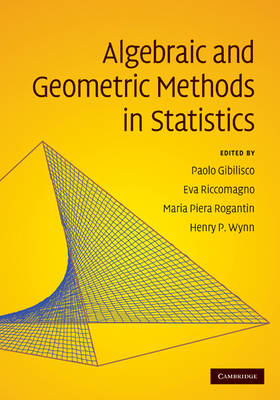
Algebraic and Geometric Methods in Statistics
Cambridge University Press (Verlag)
978-0-521-89619-1 (ISBN)
This up-to-date account of algebraic statistics and information geometry explores the emerging connections between the two disciplines, demonstrating how they can be used in design of experiments and how they benefit our understanding of statistical models, in particular, exponential models. This book presents a new way of approaching classical statistical problems and raises scientific questions that would never have been considered without the interaction of these two disciplines. Beginning with a brief introduction to each area, using simple illustrative examples, the book then proceeds with a collection of reviews and some new results written by leading researchers in their respective fields. Part III dwells in both classical and quantum information geometry, containing surveys of key results and new material. Finally, Part IV provides examples of the interplay between algebraic statistics and information geometry. Computer code and proofs are also available online, where key examples are developed in further detail.
Professor Paolo Gibilisco is a Researcher in Mathematical Analysis in the School of Economics at the University of Rome 'Tor Vergata'. Eva Riccomagno is Associate Professor in the Department of Mathematics at the University of Genova. Maria Piera Rogantin is Associate Professor in the Department of Mathematics at the University of Genova. Henry P. Wynn is Professor of Statistics at the London School of Economics from 2003, where he leads the Decision Support and Risk Group. He holds the Guy Medal in Silver from the Royal Statistical Society, is an Honorary Fellow of the Institute of Actuaries, and a Fellow of the Institute of Mathematical Statistics.
List of contributors; Frequently used notations and symbols; Preface; 1. Algebraic and geometric methods in statistics P. Gibilisco, E. Riccomagno, M. P. Rogantin and H. P. Wynn; Part I. Contingency Tables: 2. Maximum likelihood estimation in latent class models S. E. Fienberg, P. Hersh, A. Rinaldo and Y. Zhou; 3. Algebraic geometry of 2 x 2 contingency tables A. Slavkovic and S. E. Fienberg; 4. Model selection for contingency tables with algebraic statistics A. Krampe and S. Kuhnt; 5. Markov chains, quotient ideals, and connectivity Y. Chen, I. Dinwoodie and R. Yoshida; 6. Algebraic category distinguishability E. Carlini and F. Rapallo; 7. Algebraic complexity of MLE for bivariate missing data S. Hoşten and S. Sullivant; 8. The generalized shuttle algorithm A. Dobra and S. E. Fienberg; Part II. Designed Experiments: 9. Generalised design H. Maruri-Aguilar and H. P. Wynn; 10. Design of experiments and biochemical network inference R. Laubenbacher and B. Stigler; 11. Replicated measurements and algebraic statistics R. Notari and E. Riccomagno; 12. Indicator function and sudoku designs R. Fontana and M. P. Rogantin; 13. Markov basis for design of experiments and three-level factors S. Aoki and A. Takemura; Part III. Information Geometry: 14. Non-parametric estimation R. F. Streater; 15. Banach manifold of quantum states R. F. Streater; 16. On quantum information manifolds A. Jenčová; 17. Axiomatic geometries for text documents G. Lebanon; 18. Exponential manifold by reproducing kernel Hilbert spaces K. Fukumizu; 19. Extended exponential models D. Imparato and B. Trivellato; 20. Quantum statistics and measures of quantum information F. Hansen; Part IV. Information Geometry and Algebraic Statistics: 21. Algebraic varieties vs differentiable manifolds G. Pistone; Part V. On-Line Supplements: Coloured Figures for Chapter 2; 22. Maximum likelihood estimation in latent class models Y. Zhou; 23. The generalized shuttle algorithm A. Dobra and S. E. Fienberg; 24. Indicator function and sudoku designs R. Fontana and M. P. Rogantin; 25. Replicated measurements and algebraic statistics R. Notari and E. Riccomagno; 26. Extended exponential models D. Imparato and B. Trivellato.
| Erscheint lt. Verlag | 22.10.2009 |
|---|---|
| Zusatzinfo | Worked examples or Exercises; 35 Tables, unspecified; 5 Halftones, unspecified; 25 Line drawings, unspecified |
| Verlagsort | Cambridge |
| Sprache | englisch |
| Maße | 181 x 254 mm |
| Gewicht | 830 g |
| Themenwelt | Mathematik / Informatik ► Mathematik ► Algebra |
| Mathematik / Informatik ► Mathematik ► Geometrie / Topologie | |
| Mathematik / Informatik ► Mathematik ► Statistik | |
| ISBN-10 | 0-521-89619-3 / 0521896193 |
| ISBN-13 | 978-0-521-89619-1 / 9780521896191 |
| Zustand | Neuware |
| Haben Sie eine Frage zum Produkt? |
aus dem Bereich


